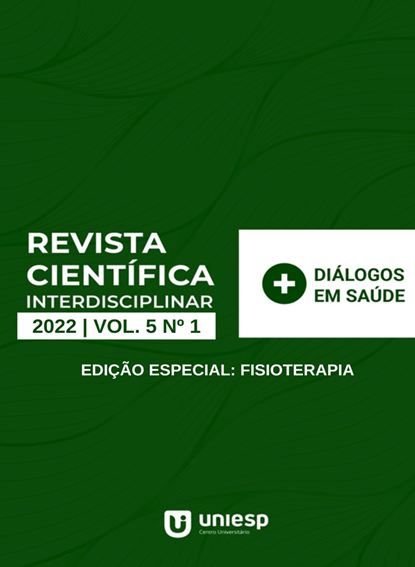OXIGENOTERAPIA DE ALTO FLUXO NA HIPOXEMIA COVID-19
Resumo
A COVID-19 é uma doença que atinge vários sistemas do corpo, em principal, o respiratório e que possui uma alta taxa de transmissão, e internações. Um de seus sintomas é dificuldade de respirar, provocando a diminuição do oxigênio no sangue e a hipoxemia. Um dos manejos para tratar a hipoxemia é o uso da oxigenoterapia. A presente pesquisa tem como objetivo analisar a literatura científica com evidências do uso da oxigenoterapia de alto fluxo no cuidado ao paciente com COVID-19. O estudo trata-se de uma revisão integrativa, com a busca dos artigos nas bases de dados National Library of Medicine (PUBMED), Physiotherapy Evidence Database (PEDro) e Literatura Latino-Americana e do Caribe em Ciências da Saúde (LILACS), com os seguintes termos de busca: COVID-19, SARS-COV-2, high-flow nasal cannula e hypoxemia, publicados no período de 2019 a 2022, disponíveis na íntegra, publicados em inglês ou português. Foram selecionados 7 artigos, em que a maior parte foi publicado em 2021, demonstrando que a CNAF pode ser uma estratégia de oxigenação de primeira linha segura e eficaz para pacientes com pneumonia hipóxica grave por SARS-COV 2. O uso de CNAF pode reduzir a taxa geral de intubação na UTI e melhorar os resultados do paciente sem aumentar o risco de contaminação pelos profissionais da saúde. Além de melhorar os parâmetros respiratórios em muitos pacientes com COVID-19, também pode reduzir o tempo de permanência no hospital e na UTI.
Palavras-chave: COVID-19; SARS-COV-2; cânula nasal de alto fluxo; hipoxemiaReferências
AARC clinical practice guideline. Oxygen therapy in the home or alternate site health care facility--2007 revision & update. Respir Care, v. 52, n. 8, p. 1063-8, 2007.
AGARWAL, A. et al. Highflow nasal cannula for acute hypoxemic respiratory failure in patients with COVID-19: systematic reviews of effectiveness and its risks of aerosolization, dispersion, and infection transmission. Can J Anaesth., v. 1, n. 1, p. 1-32, 2020.
BEDUNEAU, C. et al. Covid-19 severe hypoxemic pneumonia: A clinical experience using high-flow nasal oxygen therapy as first-line management. Respir Med Res, v. 80, n. 1, 2021.
BELENGUER-MUNCHARAZ, A.; HERNÁNDEZ-GARCÉS, H. Failure of non-invasive ventilation after use of high-flow oxygene therapy in patients with SARS-Coronavirus-2 pneumonia. Med Intensiva, v. 45, n. 8, p. 37-39, 2020.
BERNHEIM, A.et al. Chest CT findings in coronavirus disease-19 (COVID-19): relationship to duration of infection. Radiology. 2020.
CHAVARRIA, A.P. et al. High-flow nasal cannula therapy for hypoxemic respiratory failure in patients with COVID-19. Ther Adv Infect Dis, v. 8, n. 1, 2021.
DELBOVE, A. et al. High flow nasal cannula oxygenation in COVID-19 related acute respiratory distress syndrome: a safe way to avoid endotracheal intubation?. Ther Adv Respir Dis, v. 1, n. 1, 2021
GATTINONI, L. et al. COVID-19 pneumonia: different respiratory treatment for diferent phenotypes? Intens Care Med, v. 1, n. 1, p. 1-6, 2020.
GUIMARÃES, F. Atuação do fisioterapeuta em unidades de terapia intensiva no contexto da pandemia de COVID-19. Fisioter. Mov, v. 33, 2020.
HU, M. et al. Application of high-flow nasal cannula in hypoxemic patients with COVID-19: a retrospective cohort study. BMC Pulm Med, v. 20, n. 1, 2020.
MEJÍA-ZULUAGA, M. et al. Oxigenoterapia en COVID-19: herra-mientas de uso previo a la ventilación mecánica invasiva. Guía simple. CES Medicina, v. 34, p. 117-125, 2020.
MOREIRA, R.S. COVID-19: unidades de terapia intensiva, ventiladores mecânicos e perfis latentes de mortalidade associados à letalidade no Brasil. Cad. Saúde Pública, v. 36, n. 18, 2020.
PATEL, M. Retrospective analysis of high flow nasal therapy in COVID-19-related moderate-to-severe hypoxaemic respiratory failure. BMJ Open Respiratory Research, v. 7, n. 1, 2020.
SIEMIENIUK, R.A.C. et al. Oxygen therapy for acutely ill medical patients: a clinical practice guideline. BMJ, v. 363, 2018.
RAOOF, S. et al. High-Flow, Noninvasive Ventilation e Awake (Nonintubation) Proning in Patients With Coronavirus Disease 2019 With Respiratory Failure. Peito, v. 158, n. 1, p. 1992-2002, 2020.
SINGHAL T. A review of coronavirus disease-2019 (COVID-19). Indian J Pediatr., v. 87, p. 281-6, 2020.
RIVADENEIRA, T.K.P et al. Oxigenoterapia a alto flujo en COVID-19. RECIMUNDO, v. 5, n. 1, p. 37-45, 2021.
STEENKISTE, J. et al. High-flow Nasal Cannula therapy: A feasible treatment for vulnerable elderly COVID-19 patients in the wards. Heart Lung, v. 50, n. 5, p. 654-59, 2021.
SOUZA, M. T.; SILVA, M. D.; CARVALHO, R. Revisão integrativa: o que é e como fazer. Einstein (São Paulo), v. 8, n. 1, p. 102–106, 2010.
VIANELLO, A. et al. High-flow nasal cannula oxygen therapy to treat patients with hypoxemic acute respiratory failure consequent to SARS-CoV-2 infection. Thorax, v. 75, n. 1, p. 998-1000, 2020.
ZHU, N. et al. A novel coronavirus from patients with pneumonia in China, 2019. N Engl
J Med, v.382, n.8, p.727-733, 2020.
ZHAO, H. et al. High-flow nasal cannula oxygen therapy is superior to conventional oxygen therapy but not to noninvasive mechanical ventilation on intubation rate: a systematic review and meta-analysis. Crit Care., v. 21, n. 1, p. 184-9, 2017.

